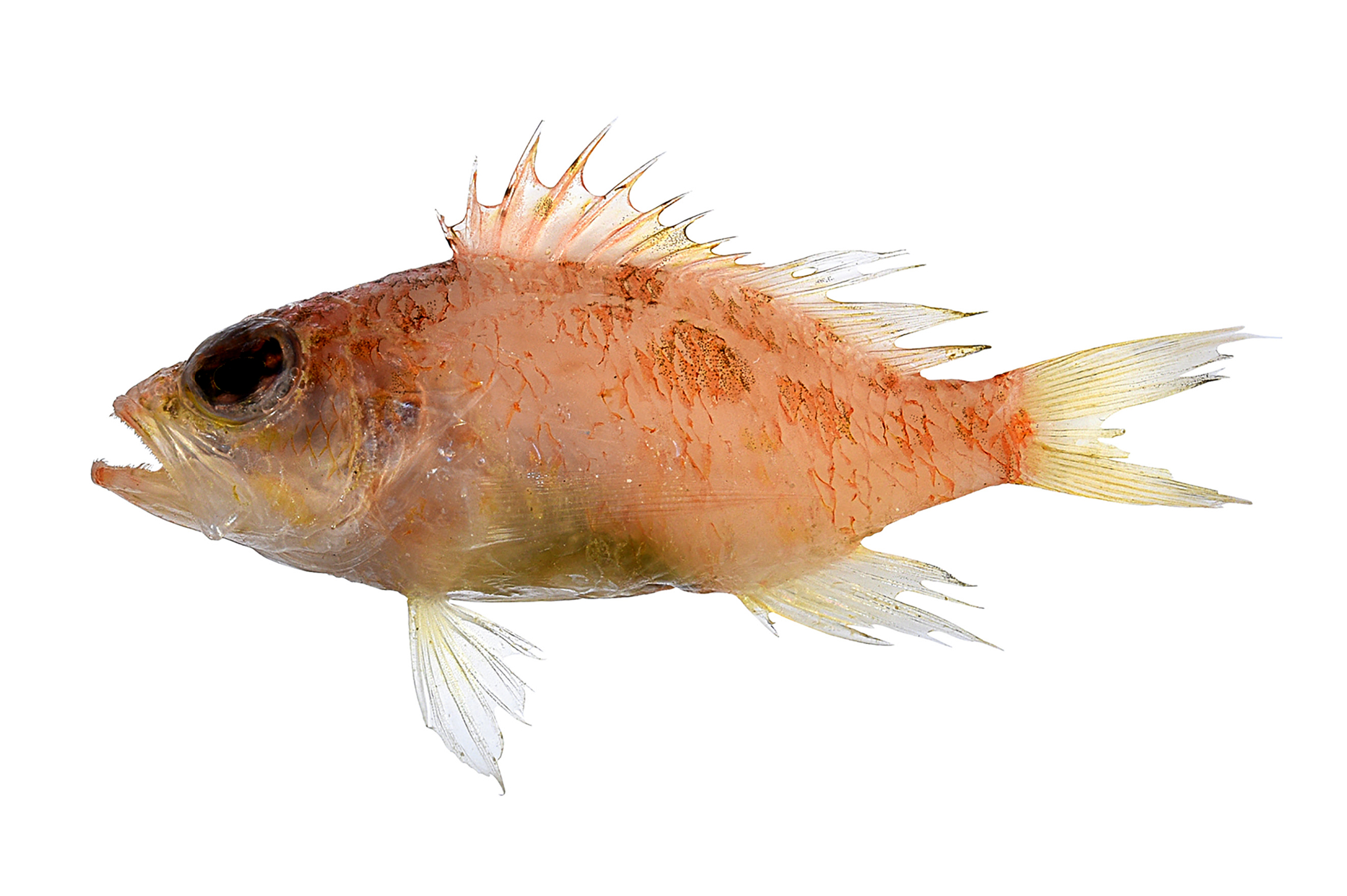- Classification
- ACTINOPTERYGII
- PERCIFORMES
- SERRANIDAE
- Plectranthias
- ferrugineus
Rusty Perchlet, Plectranthias ferrugineus Gill, Pogonoski, Moore & Johnson 2021

Holotype of the Rusty Perchlet, Plectranthias ferrugineus, CSIRO H 8289-02, 37.6 mm SL, from the Dampier Archipelago, Western Australia. Source: Modified from Fig. 17, in Gill et al. (2021) Zootaxa 4918(1): 1-116. License: All rights reserved
Summary:
A pale tan perchlet with five red-ochre blotches along the upper side, a series of five similar blotches immediately beneath lateral line, indistinct yellow- to red-ochre blotches and irregular markings on the body, a pinkish to yellowish spinous dorsal fin with one or two small reddish brown to dark grey spots on distal half of each fin spine, and indistinct dusky grey blotch between seventh and eighth fin spines, and red-ochre spot on the caudal-fin base.
Cite this page as:
Bray, D.J. 2023, Plectranthias ferrugineus in Fishes of Australia, accessed 19 Apr 2024, https://fishesofaustralia.net.au/home/species/5567
Rusty Perchlet, Plectranthias ferrugineus Gill, Pogonoski, Moore & Johnson 2021
More Info
|
Distribution |
North West Shelf, Western Australia, to the Arafura Sea, Northern Territory, at depths of 95-109 m. |
|
Features |
Dorsal fin X,14-16, all or all but first segmented rays branched; Anal fin III,7, all segmented rays branched; Pectoral rays 13-14, all rays unbranched; Pelvic fin I,5, all segmented rays branched; Caudal fin - upper procurrent rays 5-6, lower procurrent rays 5-6, principal rays 9+8, branched rays 7 + 6-7, total caudal-fin rays 27-29; Lateral line complete with 27-39 scales; Scales above lateral line to origin of dorsal fin 2-3; Scales above lateral line to base of fifth dorsal spine 1-2; Scales below lateral line to origin of anal fin 10-12; Diagonal rows of scales on cheek 5-7; Predorsal scales 15-22; Circumpeduncular scales 14-16; Gill rakers 4-7 + 11-14=16-20), the upper 4-6 and lower 2-6 rudiments; Pseudobranchial filaments 8-14; Branchiostegal rays 7; Vertebrae 10+16. Opercle with 3 flat spines; some dorsal-fin spines with short fleshy tabs on their distal tips. |
|
Size |
A relatively small species: largest specimen examined 44.6 mm SL; a 34.0 mm SL specimen was a gravid female. |
|
Colour |
Fresh coloration: head and body pale tan; head with red-ochre blotches dorsally and yellow to red-ochre blotches ventrally; anterior part of jaws red-ochre; iris red-ochre, with four dark grey spots or short streaks, two in front of pupil and two behind pupil; nape red-ochre; five red-ochre blotches on dorsal part of body above lateral line, first beneath fifth and sixth dorsal-fin spines, second beneath seventh to ninth dorsal-fin spines, third beneath second and fourth segmented dorsal-fin rays, fourth beneath seventh to ninth segmented dorsal-fin rays, fifth beneath twelfth to fourteenth segmented dorsal-fin ray; a series of five ochre-red blotches immediately beneath lateral line, first beneath fifth to seventh dorsal-fin spines, second beneath eighth dorsal-fin spine and fourth segmented dorsal-fin rays, third beneath fifth to tenth segmented dorsal-fin rays, fourth just behind dorsal-fin termination, fifth on middle part of caudal peduncle; remainder of body with indistinct yellow- to red-ochre blotches and irregular markings; spinous dorsal pinkish to yellowish hyaline with one or two small reddish brown to dark grey spots on distal half of each fin spine, and indistinct dusky grey blotch between seventh and eighth fin spines; soft dorsal and remaining fins yellowish hyaline, sometimes dusky grey distally; caudal-fin base with red-ochre central spot and ventral bar. |
|
Fisheries |
Specimens have been taken in research sleds and beam trawls. |
|
Similar Species |
The combination of 14–16 segmented dorsal-fin rays, fourth dorsal spine longest, pectoral fin with 13–14 unbranched rays, lateral line complete with 27–30 tubed scales, and lower part of preopercle with 2 enlarged antrorse spines separates Plectranthias ferrugineus from all other described species known to occur in Australian waters. |
|
Etymology |
The specific name is from the Latin ferrugineus (= rust coloured), in allusion to to the freshly dead coloration of this species. |
|
Species Citation |
Plectranthias ferrugineus Gill & Roberts 2020, Zootaxa 4750(4): 52, Fig. 17. Type locality: north of Dampier Archipelago, Western Australia, Australia, 19°26.78'S, 116°41.51'E to 19°26.97'S, 116°41.37'E, depth 103-106 m. |
|
Author |
Bray, D.J. 2023 |
|
Resources |
Rusty Perchlet, Plectranthias ferrugineus Gill, Pogonoski, Moore & Johnson 2021
References
Gill, A.C., Pogonoski, J.J., Moore, G.I. & Johnson, J.W. 2021. Review of Australian species of Plectranthias Bleeker and Selenanthias Tanaka (Teleostei: Serranidae: Anthiadinae), with descriptions of four new species. Zootaxa 4918(1): 1-116. https://doi.org/10.11646/zootaxa.4918.1.1
Gill, A.C. & Psomadakis, P.N. 2018. Pseudanthias emma new species, with notes on a collection of anthiadine serranid fishes from off Myanmar (eastern Indian Ocean). Zootaxa 4455(3): 525-536. https://doi.org/10.11646/zootaxa.4455.3.8 (as “an undescribed species from the North-west Shelf of Australia ”)



